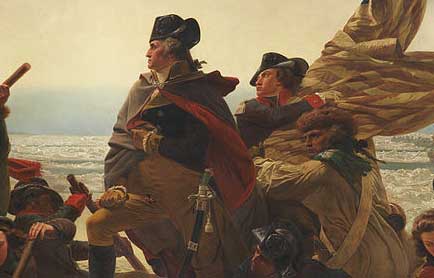Native Americans During the Revolutionary War

By Awet Amedechiel
The Americans who had inhabited the land longest were the Native Americans. They were a group made up of many tribes, differing in language, religion, social structure, culture, and geographic location. The four main regions in which Native Americans lived were the Eastern Woodlands, the Great Plains, the West, and the Southwest. The three major groups of Native Americans living in the woodlands east of the Mississippi River were the Algonquin, the Iroquois, and the Muskogean. The Algonquins lived in the forests of Northeast North America from Labrador and Quebec to Maryland and Virginia. Their society was comparatively simple, with each band hunting in designated areas, but willingly sharing the major food resources. They built snowshoes, toboggans, and canoes for transportation from the wood of the forests. The Iroquois were comprised of several related tribes which originally lived in the southeastern regions of the continent. They migrated to the northeast around 1300, driving the Algonquins out of what became New York State. By the sixteenth century, infighting among the Iroquois had risen to epic proportions. Finally, two legendary reformers, Dekanawidah, a Huron religious leader, and Hiawatha, a Mohawk chief and disciple of Dekanawidah, began to organize a union of the five tribes. Before the end of the century, the confederation known as the Iroquois League was formed out of the Mohawk, the Seneca, the Cayuga, the Oneida, and the Onondaga tribes. The Iroquois were matrilineal, tracing the family line through the mothers rather than fathers and passing property down through daughters rather than sons. Because of this, Iroquois women had more rights than some other Native American women, most European-American women, and all African-American women. Although women did not serve on the league council, they appointed the men who did.
The Great Plains area, between the Rocky Mountains and the Mississippi River was initially inhabited by Native Americans who made permanent villages. The rivers of the region provided certain water sources for farming, and the women of the Great Plains tribes were able to raise maize, squash, beans, and sunflowers. By the end of the sixteenth century, however, the inhabitants became more nomadic, possible because of drought or enemy attacks. Among these semiagricultural, seminomadic tribes were the Osage, the Missouri, the Omaha, the Kansas, the Iowa, the Wichita, the Mandan, and the Pawnee. The most powerful Native Americans in the western part were the Blackfeet, while the Crows lived between the Missouri and Yellowstone Rivers, and the southern plains were dominated by the Comanche, Kiowa, and Apache tribes.
The Native Americans living on the northwest Pacific coast had a mild climate and abundant food, with salmon and other fish, offshore seals, whales, and otter, as well as deer, moose, and elk. Since food was relatively easy to acquire, they were able to develop their artistic skills, producing large, intricately-decorated houses, totem poles, canoes, wooden masks, furniture, and utensils. They developed a complex society in which status depended on wealth. At their potlatches, or feasts, they would exchange lavish gifts, enhancing their social status.
In the Great Basin region between the Sierra Nevadas and the Rocky Mountains, tribes such as the Ute and Shoshone peoples had a more difficulty dealing with basic needs. They moved around in small, family-size bands, looking for the scarce food that was available. Adult males dominated the cultures, and women and children were given little social status.
The Anasazi people were among the first to settle in the deserts of North America. They worked the deserts until it became productive land, using dams and irrigation systems. In the canyons, they built cliff homes which resemble modern-day high-rise apartments. They drew pictures on the walls of the cliffs, and developed craft and artisan skills. The Anasazi tribe disappeared, but some of their descendants, including the Pueblos, were able to continue the ancient traditions. They built homes of stone and adobe, or sun-dried clay bricks, and farmed the land effectively. Like the Iroquois, the Pueblos were matrilineal, so women were able to hold positions of authority and influence in the home and the tribe. During the sixteenth century, the Navajos migrated into the desert regions of North America, in what would become New Mexico. They learned farming and weaving from their Pueblo neighbors, and developed a religion heavily influenced by the Pueblos. Their homes were made of logs and mud, dome-shaped hogans with log frames and earthen coverings. The maintenance of harmony with the universe was a prevailing theme in the lives of the Navajos, as well as some other Native American tribes.
Some historians assert that the English came to America with the good intentions toward Native Americans, although their cultural bias led them to label them Native Americans as barbarians. William Penn and others urged settlers to treat them with kindness and a degrees of respect, so as to draw them into English civilization. Eventually, however, many, if not most European settlers began to demonize them. Some, especially in New England, used religion as a basis for discrimination. Others used cultural differences to create a supposed hierarchy of civilizations, placing themselves at the top and Native Americans somewhere below. Still others were angered by the often fierce Native American attacks, forgetting the slaughter and degradation of indigenous tribes for which many Europeans were responsible.
 >
>